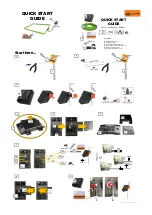
4211-7, S.7
Operation & Maintenance Instruction
September, 2017
Page 8 of 10
7.2.4.4.3Remove the choke plug (14) from its solvent and
blow it completely dry, using a low pressure jet of clean, dry
air.
7.2.4.5 Inspect the piston (13). Replace the piston if it is
bent, broken, damaged, excessively worn, or if it is in such a
condition that may result in the unsatisfactory operation of
the VX Vent Valve Portion.
7.2.4.6 Inspect the orifice of the choke plug (14) to be sure
that it is clean and that its size, 1.1mm Drill, has not been
changed.
DO NOT
use hard or sharp metal tools to clean
the orifice as its size and shape
MUST NOT
be changed.
Replace the choke plug if it is damaged in any way or if the
size of the orifice, 1.1mm Drill, has been changed.
7.2.4.7 Lightly coat the threads of the cleaned and
inspected or
NEW
choke plug (14) with the oil and graphite
compound as described in Section 6.2.2, then install the
choke plug (14) in place in the piston (13). The choke plug it
to be installed at its full travel in the piston (13).
7.2.4.8 Inspect the piston stem (17). Replace the stem if it
is found to be bent, cracked, broken, damaged in any way,
or if the size of the passage way of the stem has been
changed, (the size of the passage way
MUST BE
a 0.156"
Drill) or if the stem is in such a condition that may result in
the unsatisfactory operation of the VX Vent Valve Portion.
Be sure that all of the old locking sealant is cleaned from the
stem threads.
7.2.4.9 Inspect the springs (8,24). Replace any spring that
is cracked, rusted, pitted, broken, bent damaged in any way,
or if it has taken a permanent set.
7.2.4.10 Inspect the retaining ring (26). Replace the retaining
ring (26) if it is not elastic enough to hold securely.
7.2.4.11 Inspect the remaining parts. Replace any part that
is cracked, cut, bent, broken, excessively worn, damaged in
any way, or that is in such a condition that may result in the
unsatisfactory operation of the VX Vent Valve Portion.
7.3 ASSEMBLY
7.3.1 Apply Number 2 Silicon Grease, Wabtec Corporation
Specification M-7680-2 to a
NEW
exhaust valve seal (22)
and press in place in the exhaust valve (23), then install the
exhaust valve with seal (21), seal end first, into the bushing
in the bottom of the housing (19).
7.3.2 Install the exhaust valve spring (24) into the bottom of
the housing (19) so that the spring (24) is seated on the
exhaust vale (23), then install the washer (25) so that it seats
on the spring (24).
7.3.3
WARNING: In the procedure which follows,
the spring (22) will be compressed. Exercise care so
that no parts are inadvertently expelled from the
assembly.
Carefully depress and hold the washer (25) and spring (24)
far enough into the bushing in the housing (19) to expose the
retaining ring groove, then while holding these parts
depressed, install the retaining ring (26) being sure that it
"snaps" into its groove. Slowly release the hold on the washer
(25) and spring (24) permitting the spring (24) to extend its
full travel to seat the washer (25) on the retaining ring (26).
7.3.4 Apply Number 2 Silicon Grease, Wabtec Corporation
Specification M-7680-2 to a
NEW
vent protector seal (27)
and press in place in the washer (25). The seal (27) will
have an interference fit in the washer.
7.3.5 Install a
NEW
diaphragm (15) on the piston (13, 14)
and be sure that the inner bead of the diaphragm fits into
the bead groove of the piston (13).
Figure 5
– Piston Diaphragm (15)
7.3.6 Install the diaphragm follower (16), flat side up, onto
the threaded end of the piston stem (17), then install the
diaphragm and piston sub-assembly (13, 14, 15) so that the
diaphragm (15) contacts the diaphragm follower (16).
7.3.7 Install a
NEW
seal seat (12) in place in its groove on
the piston (13).
7.3.8 Install the washer (11) on the piston stem (17) so that
it contacts and seats on the seal - seat (12).
7.3.9 Apply a coating of locking sealant, Wabtec Corporation
Specification M-7499-5, to the exposed threads of the piston
stem (17).




























